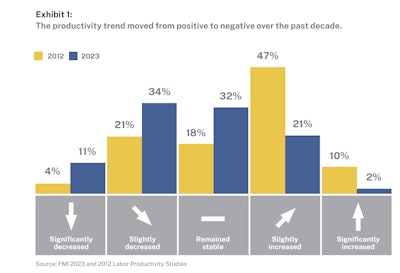
Labor productivity is a challenge for the construction industry, and it appears to be getting worse.
Of the nearly $900 billion in construction put in place by labor-intensive contractors in the U.S. in 2022, research and surveys done by FMI Corporation, a consulting and investment banking services firm, suggests contractors lost approximately $30 billion to $40 billion due to labor inefficiencies.
FMI recently released its 2023 Labor Productivity Study, having surveyed more than 250 from heavy civil trade and self-performing general contractors. The study explores the current trends, challenges, management best practices, and innovations for optimizing labor productivity.
"Despite the advancements that the industry has made in design, coordination, and management technology, the industry is still heavily reliant on people to install work," said Michael Keller, an FMI operations and performance practice consultant.
As the economic engine behind any contractor’s business, labor remains the largest, riskiest, and most controllable cost.
Keller noted that when managed well, labor under-runs typically correlate with higher profit margins but when managed poorly, labor overruns can wipe out the bottom line of an organization.
Contractors are in the labor-management business, and understanding labor costs has a clear, direct effect on profitability.
Data collected by FMI seem to confirm the overall labor productivity decline with only 23% of respondents claiming labor productivity improvements over the last 12 to 18 months. Comparatively, almost half of respondents, 45%, reported declining productivity.
 FMI
FMI
In addition, respondents overwhelmingly cited better management as a key factor in improving labor productivity. A total of 79% of survey respondents indicated that they could improve productivity by 6% or more with better management practices.
FMI's analysis of the data suggests that a 6% increase could translate to a 2 to 3% increase in the bottom line or as much as a 50% to 100% improvement in profitability.
The number one issue relating to addressing labor productivity for 63% of respondents was the lack of qualified craft labor. This mirrored FMI’s 2023 talent study which indicated that 93% of firms can’t find the workers they need, with the biggest gap in talent associated with field leadership.
Additional research indicated that companies expect a 30% turnover for field managers over the next five years, only furthering the significance of keeping staff engaged and providing the right support.
Among the remaining internal factors identified by FMI were planning, communication, and collaboration. Participants cited low-quality design and construction documents, outdated and unrealistic schedules, lack of coordination with general contractors, and change order inefficiencies as their biggest areas of concern on an external basis.
Combined, the findings indicate that weak project coordination can lead to challenges. More than two-thirds of contractors in the study, 70%, highlighted improving planning and execution practices as their top priority for adjusting operations over the next 18 months. According to FMI, leadership training and development was the second highest priority listed.
The study and research show that the accuracy of cost-to-complete forecasting also correlates with higher profit margins. Of those surveyed, 78% of contractors with extremely reliable cost-to-complete information receive productivity feedback weekly or daily. That level of confidence requires strong communication between field managers and project managers.
Results of the survey also show that the further out contractors' plans are, the fewer emergency events they have every week.
 FMI
FMI
Ultimately, FMI’s study suggests that optimization of labor productivity requires teams and individuals to adjust planning and communication habits with disciplined management practices. Some of the basic concepts identified by FMI to improve labor productivity include the following:
- Pre-job planning: Understanding and translation of project information from estimating to operations, followed by planning to develop optimized labor and project performance strategies.
- Look-ahead planning: Weekly communication of resource needs for upcoming activities coordinated by project management.
- Daily goal setting: Field leaders establish quantifiable production expectations and objectives for crews daily.
- Labor productivity tracking and feedback: Project teams require regular reporting of productivity information in digestible formats so they can discuss project performance and detect labor risks early.
- Cost-to-complete forecasting: A monthly analysis of the costs incurred to date, the percentage of the job that is completed, accurate forecasting, and re-estimating the cost to complete the remainder of the scope of work.
- Exit strategy: When the project is near 80% completion, the project team develops a plan to finish the project on time and mitigate the risk of late project margin fade.
- Post-job review: Gathering feedback from field leaders and project team leaders on the entire scope as far as where things went well or failed.
 FMI
FMI













